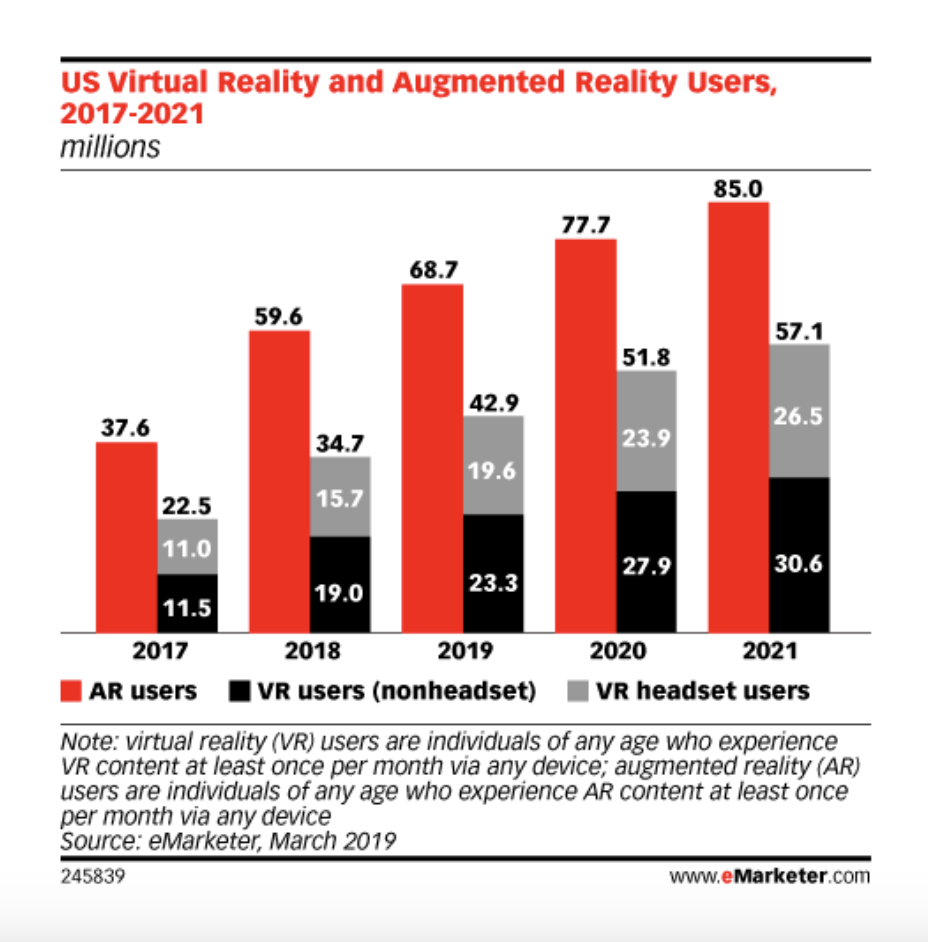2016 was the "year of VR". And so was 2017. And 2018. And 2019. So is 2020 going to be THE year? Get your headset on and let’s dive into the world of our new realities.
First things first. What is VR, AR, MR and XR? I'd have to say, this is quite a complex space with lots of different opinions on how these realities are defined, but I've done my best to break it down for you.
Virtual Reality (VR) - This is where you put on a headset and are fully immersed in a different world. Often times you also have controllers to help you engage with that world. Some of the main headset providers in this space are Oculus (owned by FB) and HTC Vive. There are also way less technical VR "headsets" like Google Cardboard. Watch this video to see a virtual shark attack!
Augmented Reality (AR) - This is where virtual things get layered onto the real world and it's typically accessed through your phone or tablet. Think Pokemon Go, Google Maps AR mode and Snapchat (filters, lenses, landmarkers, etc.). Some smartglasses also have AR capabilities with brands like Bosch teasing us at CES with super cool and not as dorky as Google Glass spectacles. Watch this video to see the Flatiron building turn into a slice of pizza.
Mixed Reality (MR) - Some call it merged reality and this is the most nascent of the three realities. This is where you put on what looks like a mix between a VR headset and smart glasses and can still see your environment. It allows for way more complex and advanced virtual things to get layered onto your environment and you can interact with it (a big differentiator bw AR and MR). You also can have hand controllers. Microsoft HoloLens and Magic Leap are leading the way here. Check out this video of playing with Porgs.
Extended Reality (XR) - The umbrella term for all of these
So how many people actually use AR and VR? It’s projected that this year 77.7MM people (24% of the US population) will use AR and 51.8MM (16%) will use VR at least once a month.
And it makes sense why VR trails AR—hurdles for adoption have to do with pricey equipment, clunky user experience and the lack of truly can't-live-without content.
The good news is that these problems are being addressed—Oculus released its Quest headset which competes on price and user experience (now you don't have to be plugged in to use it). 5G will also have a huge impact on VR.
From a content perspective, games like Beat Saber and Half-Life: Alyx are being released exclusively in VR, creating more pull into the virtual world. Is this the start of the VR streaming wars?
Even though some have deemed 2020 as "VR's make-or-break year", VR adoption is likely going to be a long game—the XR industry predicts that in the next 3-4 years is when we'll really see movement.
Unfortunately, it seems we got ahead of ourselves and that premature hype led to some VR casualties, but my hope is that the space continues to develop and build fans over time because it's a freaking blast when done right.
In the meantime, while consumer adoption continues to find its way, enterprise adoption has been thriving.
Per the XR industry report, education, architecture/engineering/construction, and healthcare are the top industries embracing these technologies.
In an interview I had with Jon Sulkow from the Outerspace Collective, he explains that "VR has been proven to be highly effective in training and therapeutic scenarios. This can be anything from learning how to operate controls at a nuclear power plant with less "Doh's!!" to helping burn victims alleviate pain by putting them into VR Snowball fights."
Mixed reality companies are focusing their efforts in the enterprise space as well—HoloLens 2 is only available for corporate purchase, not consumers. Check out this video to see how they envision the future of work.
Even though full adoption isn't quite there yet, brands are testing out these new territories to see what sticks. There are myriad examples of brands leveraging AR like Disney, Zara, Patron, IKEA, Sephora and Sherwin-Williams. Pinterest lets you try on lipstick and Goat lets sneakerheads try on yet-to-be-released kicks and share a pic on social (will there even be a reason to buy the shoes anymore?). Game of Thrones brought white walkers to AT&T stores via MR and the NBA puts you courtside via VR.
If you're a brand thinking about entering any of these realities, it's important to understand the different use cases and motivations for each.
IMO, AR is like a cherry on top of the cake. If there's a way to easily dimensionalize your brand, use AR.
Even though MR is focused on enterprise right now, I can imagine a world where mixed reality becomes the norm. For example, you get home from work and change your scenery to relaxing beach-mode, you "facetime" with friends via your avatar and whip up a delicious souffle without a recipe book.
Whereas VR, due to its immersive nature, can level up any activity people spend longer chunks of time with, providing an opportunity for escape. Gaming and entertainment are obvious, but what about being IN a book, vs. reading a book (which is starting to be tested).
What do we have to look forward to in the coming years? My favorite part of the interview with Jon was how he sees the future playing out. In his mind, "It's very possible that we could end up in a screen-less society where you do your day to day work on a layer above reality. I also think that this will lead to competition for space in your layer (layerwarz!)."
Think about this! The implications this has for advertising and media planning specifically are crazy. In addition to identifying which channels, devices, content and time of day someone is consuming media, you would also need to be prepared to know which layer someone is operating in, and how to reach them there.
This becomes an exponential expansion of how we live and consume life, while also further fragmenting an already splintered landscape.
What does this all mean? Not all technology takes off like wildfire but as capabilities advance and adoption slowly seeps into our daily lives, it seems that multiple layers of reality may become a reality. And if this happens, will we get bored with real life, or crave it even more?





